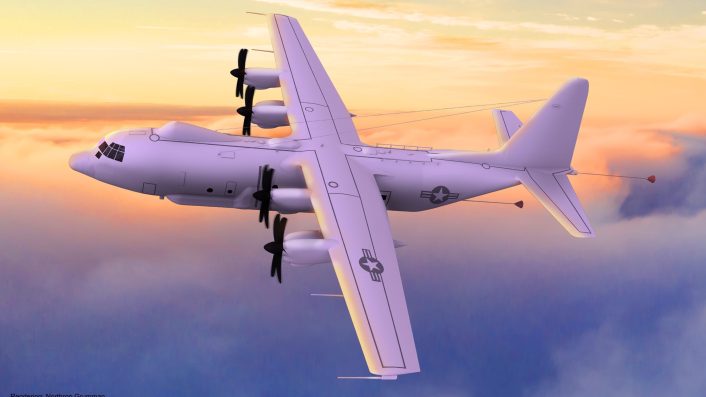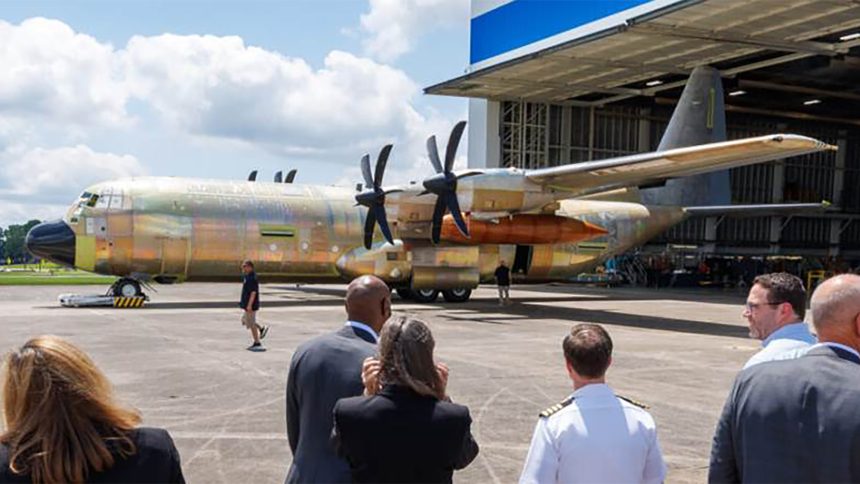The first C-130J earmarked for conversion into the new E-130J Phoenix II has rolled out of the factory, as shown in an image released by NAVAIR.
Naval Air Systems Command, or NAVAIR, released the image via social media, claiming that the E-130J Phoenix II programme is on course to meet its ‘aggressive schedule’. The E-130J, which had its designation of Phoenix II revealed earlier this month, will replace the Boeing 707-based E-6B Mercury in U.S. Navy service. This marks a return to the C-130 airframe for the TACAMO (Take Charge and Move Out) role, which was provided by EC-130Q Hercules aircraft (based on the legacy C-130H) between 1963 and 1993.
#ICYMI: E-130J program is on track to their aggressive schedule. The first airframe has emerged to be converted into the first Phoenix II. This is a testament of #speedtothefleet and fleet #readiness as the next phase of the TACAMO mission takes shape with a seamless transition. pic.twitter.com/Ybz061wl2E
— NAVAIR (@NAVAIRNews) September 4, 2025
The first E-130Js are expected in operational service around 2028. Although the first airframe has been constructed, it must still undergo a significant modification process to be fitted with the required mission equipment. This includes a comprehensive communications suite that will facilitate additional VHF, UHF, and HF radio capabilities, through to enhanced satellite communications (SATCOM) and, famously, the ability to transmit very low frequency (VLF) signals via twin trailing wire antennas. The aircraft will also receive hardening against the effects of an electromagnetic pulse (EMP), which can be generated by nuclear detonations, as well as the latest cybersecurity measures.

SATCOM will allow the aircraft to communicate with forces and military or political leadership across the world, while the VLF antenna will permit the transmission of messages to submerged submarines, particularly ballistic missile submarines (SSBNs), which would receive nuclear launch commands through this link.
Current indications suggest that the E-130J will not inherit the Looking Glass role from its E-6B predecessor, meaning the aircraft may no longer be responsible for commanding the U.S. Air Force’s fleet of nuclear bombers or intercontinental ballistic missiles (ICBMs). The E-6B is notably the only aircraft presently configured with the Airborne Launch Control System (ALCS) which allows operators on board the aircraft to remotely launch Minuteman III ICBMs, providing an extra layer of survivability by allowing missiles to be launched even if all Launch Control Centres in their respective squadrons have been destroyed. It is possible the Looking Glass mission, also referred to as the Airborne Command Post (ABNCP), will be integrated into the mission set of the Air Force’s new E-4C Survivable Airborne Operations Centre (SAOC).
US Navy E-6B Mercury #AE041A as ROKE02 is up from Vandenberg SFB two hours early to command the launch of GT-248, a MinuteMan III ICBM via the E-6s Airborne Launch Control System. This is the second time this year that this function has been tested. The launch window is… pic.twitter.com/Uwx8frktFB
— TheIntelFrog (@TheIntelFrog) November 1, 2023
In June, the U.S. Government Accountability Office (GAO) questioned whether the E-130J will meet the operational availability requirements needed by the U.S. Navy for its vital mission, and expressed concerns regarding the integration of the various technologies onto the airframes. The U.S. Navy defended its choice of the C-130J for the mission.
The new image shows the rapid pace at which C-130Js can be constructed, given our last look at the aircraft less than a year ago depicted it still as a skeletal structure. It is likely that the mission systems integration process, at least for the first few airframes, will be more lengthy than the actual construction of the aircraft.
Sneak peek at the first of three C-130J-30 Super Hercules aircraft that will be modified into an E-130J Engineering Development Model (EMD). The air vehicle is being built by Lockheed Martin Corp. for the E-130J, the successor to the E-6B Mercury for the TACAMO mission. pic.twitter.com/lnsKitbe2b
— NAVAIR (@NAVAIRNews) November 19, 2024
How many E-130Js will enter into U.S. Navy service has yet to be confirmed. The E-6B Mercury fleet due to be replaced by the early to mid 2030s numbers 16 airframes. While the E-130J’s turboprop performance will not match the range or speed of the E-6B, if the Looking Glass role is indeed removed from the requirement sheet this might allow fewer airframes to cover the remaining gap. Outwith the unspecified concerns about operational availability noted by the GAO, the base C-130 airframe attains a fairly high availability rate within the U.S. military.
While the E-130J will add additional systems that could go wrong, it also benefits from an extensive existing logistics network and knowledge base for the C-130 airframe as well as its primary sub-systems. Spare parts and maintenance equipment, even when operating overseas, will be far easier to source than for the E-6B. The Boeing 707 upon which the Mercury is based has previously been a mainstay of the U.S. military, but with the withdrawal of the E-8C and eventual upcoming retirement of the E-3 Sentry the aircraft will become ever more uncommon. Despite outward similarities, the C-135 upon which the KC-135, RC-135, WC-135 and others, are based is a different airframe (derived from a shared ancestor) with only some commonality.
While the C-130J airframe itself is constructed by Lockheed Martin, the overall effort to produce the E-130J is led by Northrop Grumman. Northrop Grumman lists the E-130J programme team as including Lockheed Martin Skunk Works, Raytheon, Crescent Systems Inc, and Long Wave Inc. The contribution by Raytheon (also known as RTX) is likely through subsidiary Collins Aerospace, who have produced the VLF trailing wire systems and radios for both the EC-130Q and E-6B as well as the E-4B Nightwatch.









